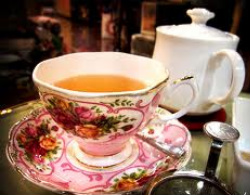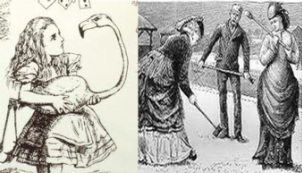Victorian Conventions
Would you like a little more tea?

Tea parties became very popular during the Victorian Era. Tea was often served during late afternoon (around 4pm) to relieve hunger as dinners were not served till 8pm. A Victorian tea party would consist of small sandwiches, pastries and sweets. There were two traditions, which were High Tea (for the working class) and Low Tea (for the wealthy population). The two types of teas also meant a difference in the food served and its objective. For the upper class, tea meant a time for the art of conversation or socialization, served with petite foods; whereas High Tea was a time for the lower class, who after a long day of work and sometimes without meals in between, to eat for the purpose of eating. The High Tea's menu would comprise of food such as meat and vegetables. See Menu.
Alice in Wonderland (Mad) Tea Party
"it's always tea-time, and we've no time to wash the things between whiles."-Mad Hatter, Alice's Adventures in Wonderland
Dirty cups, spilled tea, or broken saucers are typical at the tea party with the Mad Hatter, March Hare, and the Dormouse in the 1951 animation. In Tim Burton's film, the Mad Hatter walks across the table, disregarding the clinking of plates and falling cups and spoons. The tea party is unlike the traditional Victorian culture, in which conversation and courtesy are the purpose to a tea party. Clearly, Carroll is ridiculing the tea party by twisting it into a chaotic scene of unwashed cups. The passiveness of the party is suggested by how the Queen of Hearts "murdered time" and therefore, it will always be tea time. The tea party is static and governed by rules, and Carroll rebelliously alters the orderliness into craziness. The adapted works (1951 and 2010) both included the tea party scene, illustrating its silliness; for example, singing the "Happy Unbirthday Song". Perhaps Carroll is trying to free his audience from the constraints of Victorian etiquette and the social class structure, the expectation of oneself to do what is deemed appropriate depending on one's class in society.
Alice in Wonderland (Mad) Tea Party
"it's always tea-time, and we've no time to wash the things between whiles."-Mad Hatter, Alice's Adventures in Wonderland
Dirty cups, spilled tea, or broken saucers are typical at the tea party with the Mad Hatter, March Hare, and the Dormouse in the 1951 animation. In Tim Burton's film, the Mad Hatter walks across the table, disregarding the clinking of plates and falling cups and spoons. The tea party is unlike the traditional Victorian culture, in which conversation and courtesy are the purpose to a tea party. Clearly, Carroll is ridiculing the tea party by twisting it into a chaotic scene of unwashed cups. The passiveness of the party is suggested by how the Queen of Hearts "murdered time" and therefore, it will always be tea time. The tea party is static and governed by rules, and Carroll rebelliously alters the orderliness into craziness. The adapted works (1951 and 2010) both included the tea party scene, illustrating its silliness; for example, singing the "Happy Unbirthday Song". Perhaps Carroll is trying to free his audience from the constraints of Victorian etiquette and the social class structure, the expectation of oneself to do what is deemed appropriate depending on one's class in society.
Victorian Etiquette

"[Alice] was not quite sure whether it was good manners for her to speak first" p.70, "Alice's Adventures in Wonderland"
“Open your mouth a little wider when you speak, and always say "your Majesty." p.191
" Curtsey while you're thinking what to say, it saves time." p.190
(Red Queen, "Through the Looking Glass")
Rules and Manners are essential and construct the culture of all Victorians. Depending on different social contexts, such as attending a wedding or engagement in a conversation, different etiquette styles are present (more information can be found here). In fact, being well-mannered is part of a woman's education, if not more important than academics itself. Lewis Carroll violates this societal norm through different characters. In the text and the 1951 animation, Alice is the conforming Victorian and when exposed to a disordered Wonderland where there are no set rules, she is clearly distraught by this. She tries to preserve her mannered front but soon realizes that having good manners (besides for the monarchy) is disregarded by Wonderland's creatures, in fact communication became a frustration for Alice. To exemplify the importance of etiquette, here is an example:
"By the middle and late years of the Victorian Era, the most trivial demands of etiquette could lead to the downfall of one in the upper strata of society. Poor speech or the incorrect usage of terminology might prove fatal. As “Madge” in one of her guides to etiquette pointed out, “coffee” must be pronounced “cawffee”, “lunch” is never heard in good society–the meal is “luncheon”, calls are “made,” not “paid,” and one drinks “tea” but doesn’t “take” it." (The Hand-Book of Etiquette: Being a Complete Guide to the Usages of Polite Society)
For other notes on manners from Cassell's Handbook, here is a summary by Bruce Rosen.
In the book and the animation, Alice prefers to follow the rules and this is illustrated in the Caucus Race. She is exasperated that the Dodo bird initiates a ceremony for distributing prizes to the other animals and to herself. However, Alice follows the rules and pretends to show solemnity and respect during the ceremony. Although she does not comprehend with the Caucus Race, she does not rebel against it. In other instances when other characters, such as the Queen of Hearts is clearly violating the rules, Alice appears to be frustrated. During the croquet race, Alice is unsatisfied that croquet is played "too literally alive, without rules, order, or sequence" and alive in the sense that the Queen uses live flamingos and hedgehogs as playing instruments (Kincaid, 1973). Kincaid (1973) also mentions that the flexibility and the lack of rigidity in structure in the game is unfavored by Alice. The characters of Wonderland violate Alice's expectations of proper Victorian etiquette and rules, the clash of "order and disorder" portrayed in her difficulty in communicating fluently.
However, Tim Burton's adaptation illustrates the expectations of Alice as a Victorian woman, to be married and tend children, contrasts with her imaginative vision. The Victorian backdrop is installed at the beginning of the film; however, etiquette is less emphasized. 19-year-old Alice violates societal norms, especially when she refuses to wear stockings or corset. Alice is determined to live the life that she wants to, instead of being molded into a conventional Victorian woman. This is reflected at the end of the movie when we see Alice board the ship as an apprentice to a trading company. Her refusal to be passive and desire for independence, not having to rely on men for protection would have been criticized during Carroll's times, however for a modern audience and the motive of entertaining a movie audience, this "happy ending" is quite predictable. It reflects upon a new era, the 21st century in which etiquette is less stressed upon and the strengthening of female status today.
“Open your mouth a little wider when you speak, and always say "your Majesty." p.191
" Curtsey while you're thinking what to say, it saves time." p.190
(Red Queen, "Through the Looking Glass")
Rules and Manners are essential and construct the culture of all Victorians. Depending on different social contexts, such as attending a wedding or engagement in a conversation, different etiquette styles are present (more information can be found here). In fact, being well-mannered is part of a woman's education, if not more important than academics itself. Lewis Carroll violates this societal norm through different characters. In the text and the 1951 animation, Alice is the conforming Victorian and when exposed to a disordered Wonderland where there are no set rules, she is clearly distraught by this. She tries to preserve her mannered front but soon realizes that having good manners (besides for the monarchy) is disregarded by Wonderland's creatures, in fact communication became a frustration for Alice. To exemplify the importance of etiquette, here is an example:
"By the middle and late years of the Victorian Era, the most trivial demands of etiquette could lead to the downfall of one in the upper strata of society. Poor speech or the incorrect usage of terminology might prove fatal. As “Madge” in one of her guides to etiquette pointed out, “coffee” must be pronounced “cawffee”, “lunch” is never heard in good society–the meal is “luncheon”, calls are “made,” not “paid,” and one drinks “tea” but doesn’t “take” it." (The Hand-Book of Etiquette: Being a Complete Guide to the Usages of Polite Society)
For other notes on manners from Cassell's Handbook, here is a summary by Bruce Rosen.
In the book and the animation, Alice prefers to follow the rules and this is illustrated in the Caucus Race. She is exasperated that the Dodo bird initiates a ceremony for distributing prizes to the other animals and to herself. However, Alice follows the rules and pretends to show solemnity and respect during the ceremony. Although she does not comprehend with the Caucus Race, she does not rebel against it. In other instances when other characters, such as the Queen of Hearts is clearly violating the rules, Alice appears to be frustrated. During the croquet race, Alice is unsatisfied that croquet is played "too literally alive, without rules, order, or sequence" and alive in the sense that the Queen uses live flamingos and hedgehogs as playing instruments (Kincaid, 1973). Kincaid (1973) also mentions that the flexibility and the lack of rigidity in structure in the game is unfavored by Alice. The characters of Wonderland violate Alice's expectations of proper Victorian etiquette and rules, the clash of "order and disorder" portrayed in her difficulty in communicating fluently.
However, Tim Burton's adaptation illustrates the expectations of Alice as a Victorian woman, to be married and tend children, contrasts with her imaginative vision. The Victorian backdrop is installed at the beginning of the film; however, etiquette is less emphasized. 19-year-old Alice violates societal norms, especially when she refuses to wear stockings or corset. Alice is determined to live the life that she wants to, instead of being molded into a conventional Victorian woman. This is reflected at the end of the movie when we see Alice board the ship as an apprentice to a trading company. Her refusal to be passive and desire for independence, not having to rely on men for protection would have been criticized during Carroll's times, however for a modern audience and the motive of entertaining a movie audience, this "happy ending" is quite predictable. It reflects upon a new era, the 21st century in which etiquette is less stressed upon and the strengthening of female status today.
Let's Play Croquet

Croquet was first originated in France and introduced to England in the 19th century. It is in fact lawn tennis, and was a very popular sport for women during the Victorian Era. Players hit wooden balls with a mallet through hoops and this is illustrated in the Queen of Heart's croquet race, but dissimilar because she uses flamingos and hedgehogs, and a pack of soldiers as hoops. Women were thought to be physically incapable and croquet was targeted to be an easy sport that did not require any skills. In the 1951 animation, the flamingo and the hedgehog would understand how to coordinate together although the Queen of Hearts misses the target. This not only suggests status in the hierarchy (Queen having much greater power than a flamingo or a petite hedgehog), but also suggests women's weakness in sports. A worthy aspect to note is the picture illustrating women playing croquet, the fact that they are wearing their extravagant gowns to play is suggestive of the traditional sentiment that emerged during the Victorian Era.
